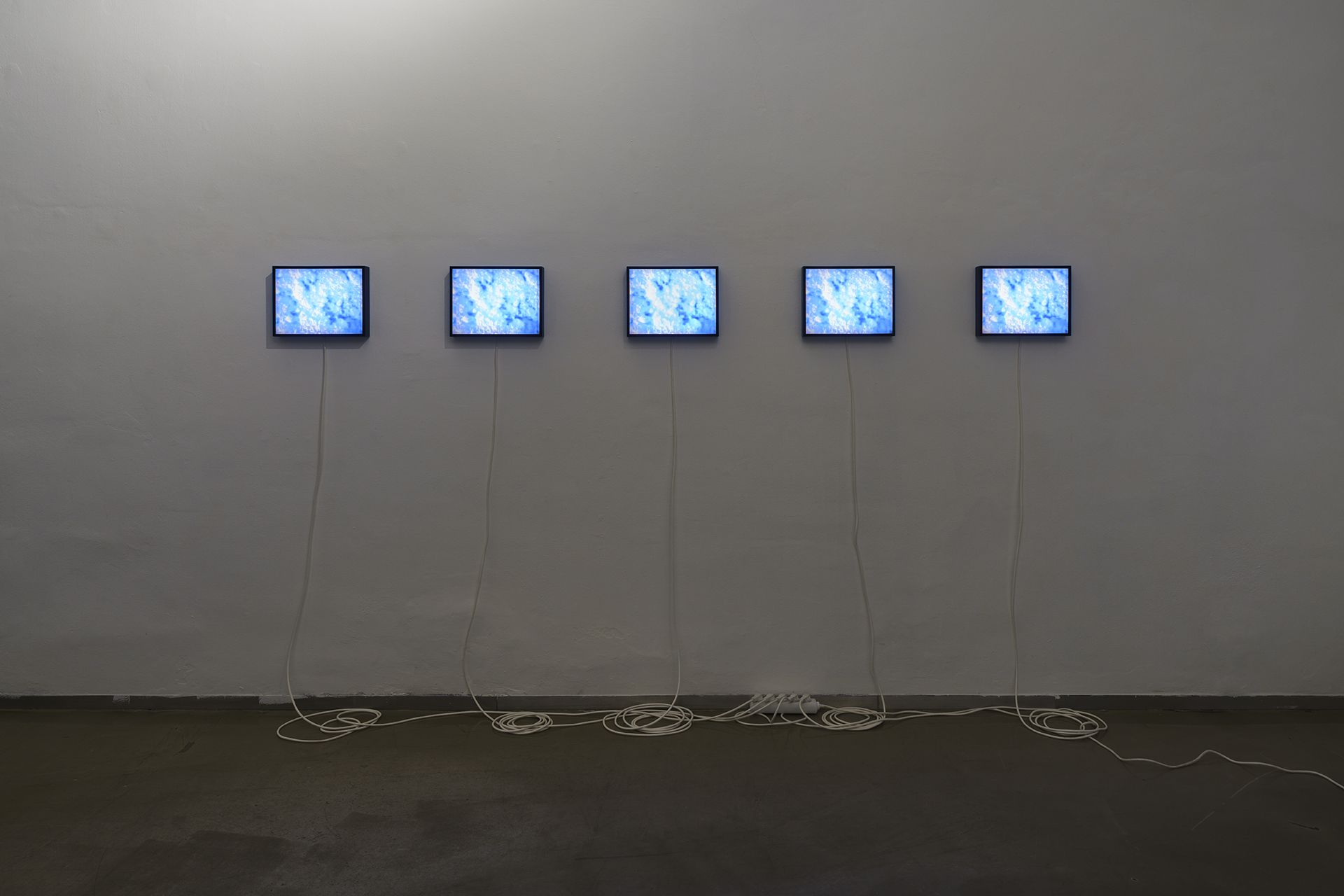
14 12
15 02
2019
Minimal Difference
Jana Bernartová, Václav Krůček, Pavel Mrkus
Curated by Monika Čejková
This group exhibition featuring three artists, Jana Bernartová, Václav Krůček, and Pavel Mrkus, deals with the transformation of visual experience through site-specific installations. The exhibition’s unifying theme is the perception of fine nuances often imperceptible to the human eye. These in turn result in minimal transformations in the image.
The theme of this exhibition, connecting the work of three exceptional artists, is minimal difference. If we decide to interpret the word difference universally, it can be the result of subtraction, or the difference between sets. This logical and mathematical approach is also Jana Bernartová’s, one of the leading Czech artists working with new digital media on a long-term basis. In this exhibition Bernartová has dedicated herself to observing the possibilities of reproducing digital colours on various digital carriers. Transferring colour between several types of media results in variable blurring. Bernartová thus uses the mathematical logic of several variables allowing for an abstract manipulation with the given blue colour and media.
“I’m interested in media which is somehow “blurred,” such as when I take an originally traditional pigment and, through its recording, create a digital colour dependent on the respective technology. For the Minimal Difference exhibition at the Kvalitář Gallery, I’ve prepared a series of light boxes with a selection from the streamed database,” explains Bernartová.
If the point of departure in Bernartová’s work is exact observation, Václav Krůček on the contrary finds minimal difference in chance and the unpredictable nature of a particular space. In his hung painting-object for the Kvalitář Gallery, incidental phenomena play the main role. These however, do not occur without a cause. The paintings created on transparent material are defined through natural and artificial lighting and their previous treatment, which consisted of applying an emulsion, as well as the viewer’s point of view.
“The approach I’ve chosen this time is more painterly, and I like it for the role that chance plays. I don’t know where the individual drops of emulsion will end up, their magnification on the wall is variable and surprising for me. The shift in shadows are unexpected shifts of minimal difference,” adds Krůček who, along with Bernartová, belongs to a group of artists the Kvalitář Gallery has been working with on a long-term basis.
The third artist included in this group exhibition is Pavel Mrkus, whose work has long been related to the societal and technological processes of a globalized world while confronting the regulations of spirituality. In his piece for the Minimal Difference exhibition, the artist has focused on differences which are beyond the capacity of human perception. This may be a measure of time or macro-measure of global changes or, on the other hand, the imperceptible micro-changes of our closest surroundings. This difference alerts us to the still ever-present anthropocentric vision of human perception and loss of the natural abilities of understanding. Additionally, difference gestures toward the two-sided substitutability of these abilities with the aid of new technology.
“Various theories and proposals to return to nature are now being discovered. One of these is, for example, Alexander Pschera’s Animal Internet detailing the interlacing of nature with data networks and the constant and wherever available online tracking of animal and plant behavior. This is supposed to help humanity reconnect to the lost ability of orienting themselves within a lost landscape. It is the principle of separation, the distance of the human, the scientist, from their observed subject: one allowing for an exact understanding while having revealed itself as two-fold. It seems that along this path we lose as many abilities as we gain knowledge. Minimal difference could therefore be a reflection of these tiny relationships, fiber lines that still connect us with the living world.” -Pavel Mrkus
Accompanying the exhibition is the publication of a book, prepared by Monika Čejková.
Jana Bernartová (*1983, Liberec) is a graduate of Stanislav Zippe’s visual communication and digital media studio at the Faculty of Arts and Architecture at the Technical University of Liberec (2007), where she now works as a pedagogue. During her studies she also went through L’uboš Stach’s photography and intermedia studio at the Academy of Fine Arts and Design in Bratislava (2006-2007) and Václav Stratil’s intermedia studio at the Faculty of Fine Arts at the Brno University of Technology (2007-2009). She finished her artistic education in 2013 as a doctoral graduate of Federico Díaz’s supermedia studio at the Academy of Arts, Architecture, and Design in Prague. Her dissertation was the artistic project Generating Texts about Generative Art.
Václav Krůček (*1955, Ostrava) is a graduate of Ladislav Čepelák’s graphic design studio at the Academy of Fine Arts in Prague (1981). In 2013, he began his doctoral studies at the Film Studies Department of the Faculty of Arts at Charles University in Prague where he is currently finishing his dissertation: Intuition and the Vacuum of the Film Image. From 1987-1994 he resided in Australia, where he received a year-long grant from the Visual Arts/Craft Board of Australia in 1992.
Pavel Mrkus (*1970, Mělník) is a graduate of both Vladimír Kopecký’s glass studio at the Academy of Arts, Architecture, and Design in Prague (1995) and the Ecumenical Institute of the Protestant Theological Faculty at Charles University in Prague (1999). Along with Daniel Hanzlík, Mrkus co-heads the Time-Based Media studio at the Faculty of Arts and Design at the Jan Evangelista Purkyně University in Ústí nad Labem.









